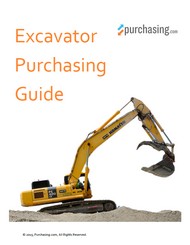Introduction to the Excavators Buying Process
Table of Contents
- Introduction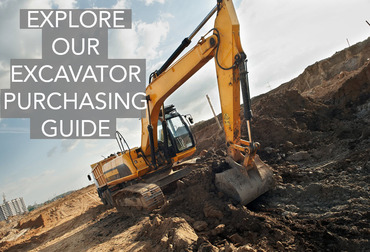
- Trends
- Types
- Specs
- Attachments
- Choosing a Dealer
Introduction
Today, excavators are state-of-the art, using hydraulic power with smaller turning radiuses for tight spaces and intuitive joystick commands. Industries such as construction, utility, public works, mining, demolition, forestry, and landscaping use them every day to dig the trenches, holes and foundations.
The components of an excavator include:
[table]
Component, Description
Cab, This is where the operator sits and controls the machine through pedals and joysticks.
House, "The house contains the engine, oil and fuel cylinders. It is connected to the undercarriage with a cylindrical casket to enable 360 degree rotation."
Engine, The engine (typically diesel because of the amount of power needed) sits in the house and powers not only movement of the machine but also the hydraulics used to move the boom and attachments.
Undercarriage, The undercarriage has the gears and motor that facilitates movement of the machine over the ground.
Boom, This is the extension that connects to the bucket and other attachments.
Stick, "The stick connects the boom and the undercarriage, extending or retracting depended on the distance necessary to operate the boom and dig"
[/table]
Choosing the right excavator depends on many factors. Size, controls, and jobsite locations rank high on the list of things to consider.
Size
The size of an excavator will determine your digging depth and dig power. The industry refers to excavators in different size classes:
[table]
Operating Size, Terminology
0 - 6 Metric Tons, "Micro, Compact"
6 - 25 Metric Tons, "Mini, Construction Class"
25 - 40 Metric Tons, "Mini, Construction Class"
40 - 90 Metric Tons, "Large, Production Class"
[/table]
You want to purchase an excavator that will meet your job requirements – and nothing more. If you purchase one that provides a deeper depth and stronger power than you really need, you could be wasting money on extra costs for fuel and possibly transport in addition to the extra expenditure on the machine itself. Really think about the size that makes the most sense for your company now and the foreseeable future.
Controls
There are two main types of excavator controls. One is specified by the Society of Automotive Engineers (SAE), and the other is by the International Organization for Standardization (ISO).
The two controls are very similar with the biggest difference being that the controls for the boom arm and dipper arm are reversed. SAE controls are the preferred method in the U.S. It's important to know the difference, especially if you are considering buying a used excavator.
Jobsite locations
Where you are going to use the machine is a critical consideration. Tight spaces require smaller machines, for instance; however, you want to look into a machine that is small but still provides the power you need.
In addition, evaluate how deep you dig and the type of breakout force you will need to get through different materials. Differences in soil types can dictate what power you need, how deep you will go and what accessories you need to break through, remove or cultivate the finished product.
Cost
When it comes to excavators, one of the decisions you'll have to make is used or new. Depending on what you choose, the prices will vary. Prices range from $100,000 for a mini-excavator to $500,000 for a large excavator.
You also have the option to rent an excavator on a job-by-job basis. If you are not going to use the excavator for every job, renting as needed may be the most cost-efficient option. Most rental companies even offer delivery as well. You can rent an excavator for $2,000 to $10,000 a month, depending on the size and type of excavator.
Leasing an excavator allows you to get the type of excavator you need for a job, at a more affordable price and for a longer period of time. While rental prices are higher for the same time period, leasing holds you responsible for maintenance and transportation costs.
This purchasing guide will discuss the trends, types, and excavator specifications that will help you choose the best excavator for your job. It will also provide information about various attachments available and suggest questions you should ask when interviewing dealers.
Trends
For the last fifty years, improvements in excavator technology focused on refining movement (cable to hydraulic operation), increasing power (engines) and reducing the turn radius (hanging counterweights to zero tail turn). Today, trends are focused on improving performance for both the machine and operator, in addition to reducing emissions. The following trends are important to note as they may influence your purchasing decision.
Controls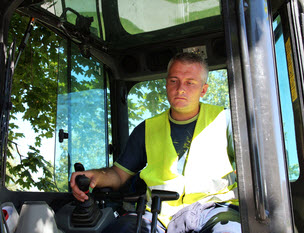
In recent years, there have been major updates to excavator joysticks to improve the ergonomics for operators. Most of the innovations have focused on making the operator more comfortable and productive while allowing for faster working speeds. The benefits extend into higher flow rates, more effective use of the engine power, better fuel efficiency, and minimizing delays due to engine stalling or overloading.
Operating an excavator used to be a complicated configuration of levers and pedals, requiring both hands and feet. This led to operator fatigue, injury, errors, and ineffective overall use of the machinery. With the joysticks, all controls are on two levers. The left hand controls the swing and extension of the stick while the right controls the bucket and boom. Joystick also use roller pads for the thumb as well as push buttons for functions.
Excavator controls have a direct impact on the productivity of your employees. Easy, intuitive controls placed in an optimal position for comfort results in longer operation times – increasing overall productivity.
Ergonomics
In addition to the joystick feature, manufacturers are trying to create healthier seats for excavators:
- Armrests are adjustable so that operators can rest their forearms
- Seat height is adjustable
- Seatbacks have adjustable lumbar support for the back and tilt options to provide a fully-ingrained sitting experience for long operating periods
Interior features are improving as well. Cab interiors have evolved from plastic and metal to an environment more like the inside of a car. Operators now have climate control, heated seats, remote start, and padded seats.
Even access to the cab has gotten easier with wider ladders, recessed steps, and platforms to give the operator room to open the door and climb in. These ergonomic improvements make it easier for an employee to do their job which results in a higher quality of work.
Tier IV engines and clean diesel fuel technology
The Environmental Protection Agency (EPA) set engine requirements to reduce emissions for new and non-road diesel engines starting in 2011. In 2014, Tier IV standards addressed nitrogen oxide emissions as well. As a result, companies have had to purchase new equipment that meets these Tier IV emission standards.
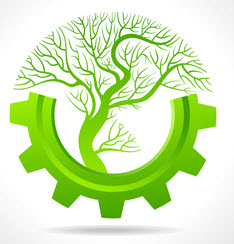 Clean diesel technology is a three-part system that combines the use of cleaner diesel fuel in advanced engines with effective emissions control technology. The purpose is to reduce the carbon footprint but it also promotes better fuel efficiency. Clean diesel contains 97% less sulfur than previous versions and is now the standard for all diesel engines. The advanced engines provide more power for less fuel usage. To adjust for the changes in fuel and engines, emissions control technology also advanced to further reduce emissions.
Clean diesel technology is a three-part system that combines the use of cleaner diesel fuel in advanced engines with effective emissions control technology. The purpose is to reduce the carbon footprint but it also promotes better fuel efficiency. Clean diesel contains 97% less sulfur than previous versions and is now the standard for all diesel engines. The advanced engines provide more power for less fuel usage. To adjust for the changes in fuel and engines, emissions control technology also advanced to further reduce emissions.
In a recent heavy equipment buying trends study, excavators saw the highest shift in buyers buying new equipment versus used as a result of this requirement. While compliance is on the manufacturer, construction companies have discovered their clients are also demanding that their contractors comply, especially in the government sector. Not having compliant equipment can affect your ability to bid and win new work.
Back to top
Types
There are different types of excavators. While most can be used for a variety of purposes with the right attachment, each has its own particular features that make it ideal for certain tasks or industries.
Compact excavators
Compact excavators (AKA mini excavators) are earth moving machines used primarily in landscaping and forestry industries with some light construction. Compact excavators work well in tight spaces with a smaller undercarriage width and zero tail swing. They weigh nearly one ton and have a dig depth of zero to six feet. A standard compact excavator package includes a backfill blade and independent boom swing.
- Price ranges from $20,000 to $35,000 for new models.
Crawler excavators
These multi-purpose machines are the most common, weighing up to 4 tons. They dig trenches, lift pipe and have a variety of attachments to increase their usefulness and efficiency. They are more balanced and stable while in use, even on rough terrain, and are less apt to get stuck.
- Price ranges from $100,000 to $500,000 for new models.
Dragline excavators
Dragline excavators are among the largest earthmoving machines and can weigh up to 10 tons. Used in civil engineering, surface mining and large excavation projects, they help build roads, extract coal and dig in quarries.
Instead of power digging into the earth, dragline excavators drop the bucket with a drag line attached above the material to be extracted, drag it along the surface and then lift the full bucket. The bucket is swung over to the truck or area where material is to be dropped. The drag line is released, causing the bucket to tilt and empty.
- Price ranges from $210,000 to $650,000 for new models.
Long reach excavators
This type of excavator is great for low, hard-to-reach places. It features an extended arm that can extend 40 to 100 feet. Industries that work in and around waterways prefer these machines because they can dredge material from underwater locales. They also have a lower center of gravity in their counterweight making it possible to reach further out without sacrificing stability.
It's important to note that long reach and high reach excavators are not the same thing and cannot be used the same way. High reach excavators are used primarily in demolition; for instance, to reach high buildings and “pull” down the walls in a more managed fashion than a wrecking ball. The attachments used in demolition exert high side-twisting forces that make long reach excavators unstable. High reach excavators, therefore, have devices that restrict the operating radius of the machine while in use.
- Price ranges from $150,000 to $450,000 for new models.
Suction excavators
This excavator has one-foot wide pipes to remove material, using suction to pull it up. It's an extremely large machine that weighs 7 to 32 tons and has up to nearly 400 HP.
Utility companies prefer this excavator as it reduces damages by more than 50%. Excavating using suction is a very controlled process. Operators can switch the suction on and off from the cab to immediately respond to possible problems, like large material or a clog in the pipe.
- Price ranges from $250,000 to $600,000 for new models.
New vs used excavators
The biggest reason to buy new excavators is the EPA Tier 4 requirements. Non-road diesel guidelines came into effect in 2011; as a result, some older fleets are still not yet compliant. It could also mean that used excavators are not as operator friendly or fuel efficient. Given all the potential gain in fuel costs, improved safety and employee retention, the cost of a new machine has multiple payoff points.
While the trend has been towards buying new models, used excavators are still a viable option because they are more affordable and just as dependable. Many sellers include maintenance reports and inspection sheets demonstrating care and history of the machine.
Back to top
Specifications
Before settling on an excavator model, it's imperative that you compare specifications. Specs will help you determine if the model you want can actually meet the job you need it for.
Dig depth
Maximum dig depth is how far down the machine will power the boom and bucket; essentially, how deep a hole you can dig or remove materials. A good tip is to calculate the range of depth from previous jobs.
- Identify the lowest and deepest depths
- Figure out how often you dig that deep
Gathering this information will prevent you from spending extra money on an excavator with excess depth. Dig depth impacts price because of the engine power and counterweight necessary to achieve it. For example, within crawler excavators, dig depth can range from 6 feet to 25 feet, resulting in every foot of added depth equaling an 8% increase in corresponding price.
Dump height/bucket capacity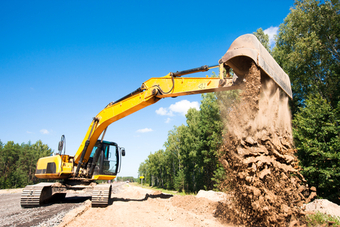
Dump height is important, particularly if you are going to be placing exhumed materials on a truck to be hauled away. You need to be sure the boom and bucket will clear the sides of the dump truck. If you are moving material around a jobsite, dump height is not as much a critical factor.
For example, compact excavators have a maximum dump height of 13 feet while crawler excavators have heights that exceed 30 feet.
Bucket capacity impacts how much material can be removed at any one time. For large excavation projects, time is critical. However, for more precise projects, a smaller bucket capacity allows for consistent operation. Bucket capacity does not have a large impact on price as different types and sizes of buckets are available as accessories.
Weight
An excavator's weight has no impact on price. However, weight does have two areas of consideration.
- Surface damage: weight of the machine can be a factor if surface damage is a concern. For instance, if most of your jobs are landscaping, minimizing damage is probably a priority. Therefore, the less the excavator weight, the less damage there is likely to be. So even if a job takes longer or requires more trips, a smaller machine is the better value for you.
- Operating weight: not to be confused with equipment weight, operating weight is another way to describe the counterweight. For instance, an excavator with an operating weight range of 4 tons means that the load at the end of the boom cannot exceed 4 tons.
The information plate of the excavator will tell you the minimum and maximum operating weight. It's important to note that the maximum operating weight is a full bucket load with the boom and stick at its furthest extension.
Size
Jobsite location is a crucial factor to consider as you think about the size of excavator you want to purchase. Important questions to ask include:
- Do you work in tight spaces with limited turning radius?
- Do you work in wide open spaces?
- Can you transport the excavator?
- What terrain will you be working on?
Mini excavators are a great option for tight spaces and jobs that do not require a lot of power. They are versatile and easy to transport as well. Larger excavators require larger trailers with a higher weight tolerance.
Engine power
Engine power goes hand in hand with maximum dig depth, weight and size. All work in tandem to get the job done right. As you compare machines with similar specifications, it's important to also think about engine type. The type of engine you go with will ultimately impact fuel and maintenance costs.
[table]
Compact, Crawler, Heavy
Under 20 tons, 20-40 tons, Above 40 tons
95 - 120 HP, 150 - 275 HP, 367 - 532 HP
[/table]
As you can see, within each category of excavator, there horsepower varies. By selecting an excavator that meets the job requirements with a minimum amount of horsepower, you save money in the long term while reducing your initial expenditure. It can be easy to get sucked into “just in case” scenarios requiring greater capability. But unless those scenarios are likely, going bigger with more power could do more harm than good.
Back to top
Attachments
You can increase the productivity of your excavator by simply purchasing a wide variety of attachments. Attachments replace the bucket to perform other job functions, such as posthole digging, backfilling, breaking up concrete or sorting materials. Quick coupling links that make it easy to switch attachments and universal hydraulic links allow operators to move seamlessly from task to task, making the most of their time on site.
Popular attachments which we discuss in this article can be organized as follows:
[table]
Light Duty, Price, Heavy Duty, Price, Landscaping, Price
Auger, $200, Auger (with teeth), $400, Bucket, $300
Bucket, $400, Breaker, "$1,000", Clamp, $350
Clamp, $450, Bucket, "$2,500", Flail Mower, $600
Grading Blade, $750, Grading Blade, "$2,500", Grading Blade, $700
Grapple, $600, Grapple, $800
[/table]
Other popular excavator attachments in heavy construction include:
- Couplers. Couplers use a small pin to lock a robust rear pin in place. These ultimately allow operators to change out attachments faster, saving time and increasing productivity.
- Hydra Tilt Swing. This attachment allows the operator to angle the bucket 30 degrees to either side. Uses include creating slopes, cleaning drainage ditches, contouring and grading.
- Thumbs. Thumbs work like a clamp. It attaches to the trenching bucket to help pick up broken concrete or other materials. It works with the existing hydraulic system.
- Rakes. Rakes separate debris in the work area of the job site. They can angle up to 25 degrees to the left or right for increased versatility. They can also level, fill, and grade.
- Rippers. The ripper attaches to the front of the bucket and is used to penetrate frost, frozen or hard ground like shale and limestone.
- Plate Compactor. The compactor attaches in place of the bucket and compresses the soil in a trench, eliminating the need for a worker in the trench using a hand-operated version.
Manufacturers offer options in addition to those that come standard. The following optional features may be available:
- Monitoring systems. This option allows you track your excavator and monitor its operations. Variations include fuel monitoring, geofence infractions, idle hours and program preventative maintenance.
- Power boost modes. Power boost increases power to the hydraulics to give a little extra muscle when needed by pushing a button on the joystick.
- Angled backfill blade. While most compact excavators have a backfill blade, choosing an angled blade allows the operator to push materials to the side with fewer passes.
- Climate-controlled cabs. This gives the operator the ability to operate in comfort. He or she can cool down in the summer or warm up in the winter.
- Anti-vandalism features. These features include locks, cab guards, and location tracking.
Many of these options are also available as after-market add-ons if you purchase a used model. Most add-ons cost between $400 and $1,500. Monitoring features may require additional monthly fees for data to transfer the excavator information in real time.
Back to top
Choosing a Quality Dealer
It's important to not only choose the right excavator for your job, but to also choose a dealer who meets your needs. The dealer you choose should have a wealth of knowledge on the equipment they sell. By asking them the following questions, you'll be able to come to a solution that's right all around.
 Training
Training
Excavators are a large and potentially dangerous piece of equipment. While it's not required to have a specialty license or certification, you're putting your business at risk if operators don't have them. As a result, ask your dealer about training options for your operators; whether operators can go to a facility to train or your dealer can provide a teaching course.
Maintenance
Ask the dealer about routine maintenance requirements: can maintenance be performed in the field, at your shop or at the dealer’s location? You will want to make sure that you do not take any action that could possibly void a warranty.
Excavators will require routine service. The intervals are determined by the hour meter reading. Maintenance tasks include items such as:
[table]
Service Interval, Description, Service Action
10 hours, "Fluids (hydraulic, engine, radiator)", Check and add fluids
50 hours, Track Tension, Check and adjust
250 hours, Battery, Check and clean
500 hours, Engine Oil and Filter, Change
"1,000 hours", Swing Reduction Gear Case, Change
"2,000 hours", Radiator Coolant, Change
"5,000 hours", Hydraulic Oil, Change
[/table]
The dealer should provide you with a complete list of such actions when you make a purchase, specific to the manufacturer and model.
Support and warranties
When problems occur, they are more likely to happen at a job site than anywhere else. Does the dealer offer on-site service if excavators need it immediately? Do they have parts on hand for that model? Downtime is lost money.
A traditional, new excavator warranty policy is full coverage for 3 years or 3,000 hours, whichever comes first. It may vary by manufacturer. Warranties on used excavators are on the powertrain and hydraulics. The industry average period is 3 years or 5,000 hours.
Get Quotes
- We contact sellers
- They compete for your business
Inspection tips
Whether you are looking at buying a new or used machine from a dealer, inspect it before you buy it. Here are some things to look for:
- Machine engine. Have the dealer start it up. Avoid engines that start with a lot of smoke. If the dealer says, “It just needs…”, it is probably one to stay away from unless they agree to make the necessary repairs at their expense before you buy.
- Play in the swing radius. While it is started up, check for play in the swing radius. It should move smoothly. If it doesn’t, there may be problems with the slew ring. Also check the connection points and make sure everything is tight there too.
- Body and interiors. Look for cracks or dents in the exterior. They can mean that overall structural integrity has been affected.
- Leaking. Also keep an eye out for leaking fluids under the machine that could suggest hose problems. Check along the loader, cylinders and interior fluids. Coolant in the oil or vice versa is a very bad sign.
- Tracks and undercarriage. Many of the parts of the undercarriage are moving components, making them subject to wear and tear. Avoid loose tracks, missing or loose bolts and chipped or broken sprockets. Examine the tracks to make sure they are clear.
- Scalloping. This check is a visual examination of the excavator bucket teeth. Look at the space between and look for half-moon shapes, or scallops. If you see them, it is an indication of reduced cutting force that may lead to having to replace the bucket.
